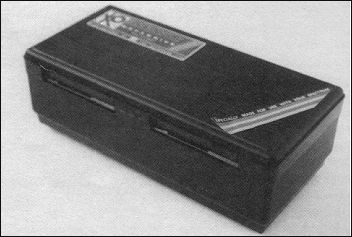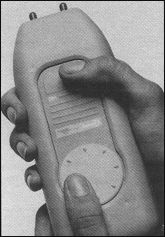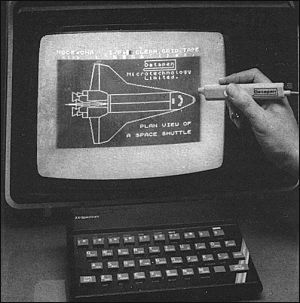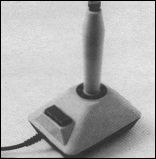| Hardware World |

THE ROTRONICS Wafadrive is likely to be the main competition to the Sinclair Interface One and microdrives.
The unit is more compact and better designed than Sinclair's, containing both RS-232 and Centronics printer interfaces as standard.
The power for the drives is taken from the Spectrum user port and fed through a ribbon connector which is fitted onto the base of the Wafadrive. That connection could be a disadvantage as it limits the range of other peripherals that can be put onto the user port at the rear of the drive unit.
The large manual supplied with the drive shows that the storage medium contained within the cartridges can have 16K, 64K or 123K formatted capacity, approximately 40K more than a ZX Microdrive.
Before use a tape cartridge has to be FORMATted. Once that has been done the drive will display drive name, wafer name, list of files, type of code, size of each file and how much space is left on the wafer.
Once SAVEd, programs are easily LOADed. The drive is slower than a microdrive but faster than cassette. It is also more reliable than the Sinclair storage unit and all Basic programs run after LOADing from it ran first time.
Backing up programs is easy with the Rotronics unit. Code can be copied from drive A to drive B using the system software supplied by the manufacturer. Cartridges are, however, guaranteed for a lifetime of 5000 hours and, at a cost of £3.99 each, they represent better value than the Sinclair cartridges.
One small criticism of the drives concerns the printer interfaces which use push-on connectors. It is possible that they might wear quickly if maltreated and that normal plugs might have been better. The Wafadrive is sold with two manuals, two free wafers, a word processor package together with an extra manual describing its use.
It costs £129.00 and can he obtained from Rotronics Ltd, Bucks.
STORING microdrive cartridges has, up to now, been a problem but the new Cartridge Box from Transform should solve it. Made to match the Spectrum and QL, the flip top box will house 20 cartridges and has space to hold record cards in the middle. Any number of boxes can be slotted together.
Priced at £5.95 the boxes are available from Transform Ltd, Kent.

Conventional joysticks are dead! claims Cheetah Marketing, unleashing the RAT upon an unsuspecting public. The RAT - Remote Action Transmitter - is a joystick with a difference, remote controlled, working up to 15 feet from the receiver unit.
The receiver unit has a user port connector and a rear edge connector for other add-ons. The unit picks up infra-red beams from the hand set, which is touch sensitive and similar to TV remote control. The handset has two touch pads which work in a similar manner to the ZX-81 keyboard. In the base is a compartment which takes a PP3 battery. The RAT is operated by pointing its nose at the screen and pressing its pads.
The RAT was tried on several games, and was found to be hard on the hands because of the pressure needed to push the pads.
When used on TVs with a remote control facility, the RAT changed channels constantly without controlling the objects on the screen. Cheetah assures us that this bug has now been eliminated. On other TVs and monitors the RAT worked well.
Retailing at £29.95, the RAT can be run to ground in High Street chain stores and computer shops.
FROM Computer World comes a reset switch for the Spectrum which does not involve opening up your computer, and thus does not invalidate the guarantee.
The switch avoids constantly removing the power lead when resetting the Spectrum, although putting the switch on top of the case would have been better, as you must hold the case each time the switch is pushed. Instead there is a light emitting diode (LED) on the top to tell you the power is on.
The main reason for having this type of outside reset switch is to save your power socket and plug from all the wear and tear it would receive in normal use.
Priced at £4.99, the switch is available from Computer World, Kent.
THE DATAPEN, from Datapen Microtechnology Limited, is completely self-contained, all interface electronics being stored within the main body of the light pen.

A light pen is an input device which can be used instead of the keyboard. By using it to point to areas on the screen changes can be made to a display such as option menus. A pen can also be used to draw pictures on the screen and saves time when trying to produce accurate screen diagrams.
The manual supplied with the Datapen is technical in some parts but the information provided should allow most people to get to grips with it. It explains that if you want to use the pen in your own programs you will have to know something about machine code.
One problem found when fitting the light pen was that the interface is dead ended. That means that you will not be able to add other peripherals onto the back of it.
The Datapen is different from other light pens as it incorporates a switch which enables you to use the pen without having to look at the keyboard for guidance. There is also an indicator which when lit tells you that the pen is looking at a light area of the screen and when unlit it is pointing at a dark area.
There are several programs supplied with the instrument the first of which gives an introduction to the mechanics of the pen and how to use it. The other programs show how the Datapen is capable of drawing graphic shapes and the type of accuracy that it can achieve when producing diagrams on the screen.
The Datapen is one of the best pens on the market and we suggest you check it out before buying anything else. It is available from Datapen Microtechnology Ltd, Hampshire for £29.00.
AN ALTERNATIVE to the Sinclair Research microdrive extension cable has been brought out by dk'tronics.
The cable is much the same as the Sinclair one and is about eight inches long with a connector plug on each end and a key which will stop you from plugging it into the wrong end of the interface or microdrive.
The dk'tronics interface cable is much longer than the one from Sinclair and that helps to reduce the cluttering up of space around the Spectrum keyboard. The cable costs £5.95 and can be obtained from dk'tronics, Saffron Walden.

The new Zipstick from Cookridge Computer Supplies, is a competition-style joystick designed for a long life of furious action. It is compatible with all standard interfaces, such as Kempston and Sinclair, and has the D-type plug on it.
Standing seven inches tall the unit has several good features - rubber feet to stop it sliding and two separate fire buttons, one of which is a bar, while the other is on top of the stick. Made out of ABS high impact plastic with stainless steel springs, it is a good looking, easy to use, joystick and is guaranteed for two years.
Priced at £12.95 inc. p&p, the Zipstick is available from Cookridge Computer Supplies, Leeds.
NEW from OEL is the TTX 2000 teletext adaptor for the Spectrum.
The unit is a decoder allowing you to look at and print out hundreds of pages of information transmitted free with the normal television broadcasts, but usually invisible because teletext is at the top of the screen. The service is free to those with a decoder, normally fitted inside a TV. A TV-type decoder uses a remote key pad whereas the TTX 2000 uses the Spectrum keyboard to access the information.
Teletext is up to the minute information on many different subjects; sport, news, weather, stock prices and even some computer games are included. Both the BBC and ITV transmit teletext, called Ceefax and Oracle respectively. All the channels offer comprehensive indexes, so making it quick and easy to find information. The advantage the TTX 2000 has over normal teletext televisions is its ability to save to tape or microdrive as a screen or to a printer.
Supplied with the decoder are an 18 volt power supply, a manual and a three-way connector lead. All that is then required is a strong television signal.
It costs £143.75 which represents good value and is less expensive than buying a teletext set. It can be obtained from OEL, Cumbria.